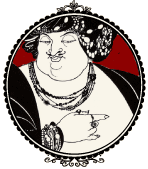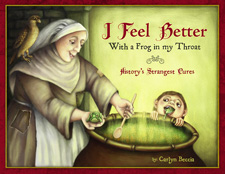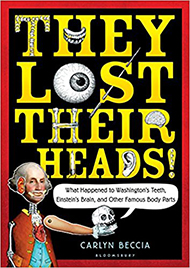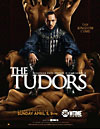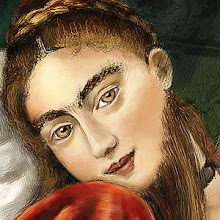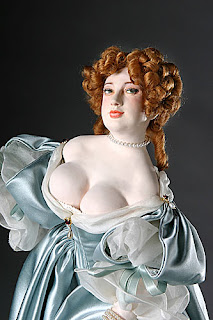The Historical:
Episode 1 starts off extra steamy. I mean
really steamy. Everyone is dripping in sweat. London at the time was going through a nasty heat wave where so little rain fell that many commoners were suffering through crop failures and plague outbreaks. To Henry and his royal party, the lack of rain only meant one thing – more time to enjoy themselves. Kathryn insists that all her ladies start dressing like French women and wear their French hoods with pride. (French hoods were the mini skirt of their day. The more hair you showed…the more scandalous.) Henry decides to go on progress and show off his new queen. Meanwhile, Kathryn is getting spoiled rotten by an endless flow of jewels and castles. (Henry gave her more gifts than any of his other queens.) And all she has to do is giggle every two minutes and make naughty puppet shadows. What a life! Her only thorn in her side is Mary, who just can’t seem to warm up to her Dad’s new misses. It might just be the age difference.

Kat does have her admirers. Thomas Culpepper just can’t seem to stop commenting about her bottom. How treasonous! Ok that part is a bit silly, but the rape scene is legit. In a letter from Richard Hilles to Henry Bullinger he relates:
One of the parties who was first hanged and afterwards beheaded and quartered for adultery with the Queen was one of the King's Chamberlains, and two years before or less had violated a park keeper's wife, whom three or four attendants held down for him in a thicket. But for this he was pardoned by the King, and likewise for a murder committed when some villagers tried to apprehend him for the crime.(1)
You would think having a mud slinging, new chippy would make Hank a bit more forgiving, but nooooooo. Before he leads for his progress, he does a little spring cleaning in the Tower and executes some notorious prisoners including John Nevill and Lord Dacre. True: Lord Dacre was imprisoned for robbery and people were shocked and saddened by his execution. (He was only 17). False: John Nevill was pardoned.
Hollywood:
Timelines get a little wonky. According to the Tudors, King Francis proposes marriage between his son Henri II and Henry VIII’s daughter Mary. This would make Francis pimp daddy to a suspiciously bigamist marriage because Catherine de Medici was already married to Henri in 1533. Catherine had enough trouble beating off her husband’s mistress, Diane de Poitiers without dealing with a second wife. Francis did propose this marriage alliance. It just happened earlier.
Kathryn knew Culpepper before becoming queen of England. There were rumors floating about that they were to marry before she came to the attentions of the king. The Tudors seems to imply that they are just getting to know each other.
There is a scene where Henry’s boys talk about the cruelty of French court. I didn’t quite understand this scene? Yes, the English always saw the French as uncouth and the French saw the English as positively barbaric, but the English court system was ten times harsher than France’s criminal system. In England, a man could be hung for stealing a sheep. France, would take the lesser punishment of removing a limb or two. One of the gentlemen mentions that Francis took delight in setting puppies on fire. Francis loved dogs, especially his beloved masties. The only time (that I know of) of animals being burnt was during Elizabeth I’s reign. As part of her coronation ceremony, cats were placed in a huge basket and lit on fire to symbolize the releasing of demons.
Francis Dereham is missing. He was the boyfriend from Kat’s past that really got the whole infidelity investigations rolling. Maybe he appears next episode.
I am not sure where they are going with Joan Bulmer cast as the lesbian intriguer. It is true that Joan wrote to Kathryn to secure a position and she was well aware of Kat's past. But the person to really bring down Kathryn was Mary Hall at the insistence of her brother, Protestant reformer, John Lassells. The writers did use some real quotes from history - (ie. the letter, the comment about hanging from their bellies like sparrows and the huffing and puffing that she heard. )
Thomas Howard, Earl of Surrey was the son of the first Thomas Howard, Duke of Norfolk thereby making him and Kathryn cousins. Not his niece. But the Duke of Norfolk disappeared in earlier seasons so someone now has to play the villian. It is true that he was a bit of a cad and had spent some time in France skirt chasing. So they have the rough outlines of his character correct.
Anne Stanhope gets further defamed in season four, but there is no proof that she was the little trollop that she plays. I already addressed her
portrayal in last season.
In 1542, Henry decided to invade Scotland, not France. I know die hard historical lovers are going to having a hard time with this one. I understand why they chose to portray France as the main rival. Firstly, France and England were not exactly chummy at this time. Second, they have already established France and England as the Tom and Jerry of the 16th century. Bringing Scotland into the mix would really muddy up plotlines espcially when they would have to bring Henry's sis, Margaret back from the dead and marry her off to the right king.
Conclusion:
Season four will probably be the most controversial regarding accuracy because so much of what we know about Kathryn comes from her enemies making it difficult to know if she was an ambitious queen or just a foolish, party girl.
Overall, I was prepared for the writers to cast Kathryn, Henry and Culpepper into the same tedious love triangle that fictional portrayals have in the past. Henry is usually typecast as the lecherous, pathetic aging husband. Kathryn is seen as the young victim unable to escape the attentions of a king. And lastly, Culpepper plays the role of valiant, romantic suitor who will risk anything to be with his lady love. The truth is less cliché and not nearly as much of a snore.
Henry, although definitely a bit pudgy and nursing a leg wound, was still hunting with his men every morning for at least two hours. Although he certainly needed to cut back on the swan binges, he was not the corporal beast of his final years. I think the Tudors did an incredible job showing Henry aged but still sexy.
Then let’s take Kathryn’s actions to appoint her past partners in crime to such visible positions as court. Was this a mark of her naivety? Or does it show a certain recklessness stemming from that arrogant Howard pride? The Tudors lets the viewer decide. They show Kathryn both giddy and foolish one minute and then haughtily announcing, “I am queen now. Do as I command.” I tend to think it was a little of both.
Lastly, I was really expecting a swashbuckling Culpepper to come striding up on his white horse serenading his love beneath her window. Instead, The Tudors shows a far creepier Culpepper capable of tremendous brutality in the rape a village girl. Culpepper is no hero. His violent actions are partly due to the indifferent cruelty of his times and partly due to how he viewed women as dogs to be kicked around.
I am hoping that in the next few episodes Kathryn will do a little less giggling and become a bit more multidimensional. Kathryn did have a benevolent side that seems to have ended up on the cutting room floor. For example, Kathryn intervened to save the life of several of her friends and relatives. She saved the life of Helen Page, rescued her cousin John Leigh from the Tower and of course her most famous intersession on behalf of poet Thomas Wyatt. Maybe that will come in next episode….
I am not sure if I am going to have time to continue this thread as thouroughly as last season. I am still getting woken up every 2 hours by a 6 month old that acts like a newborn and the sleep deprivation is seriously hurting the ole memory. Plus, I really have a book proposal that needs to get out. So if I missed any inaccuracies or mixed anything up then just write in the comment below. There is a page for Historical Inaccuracies of Season 4 over at the Tudor Wiki so keep checking it for updates.
(1) From: 'Appendix', Letters and Papers, Foreign and Domestic, Henry VIII, Volume 17: 1542 (1900), pp. 706-712.

